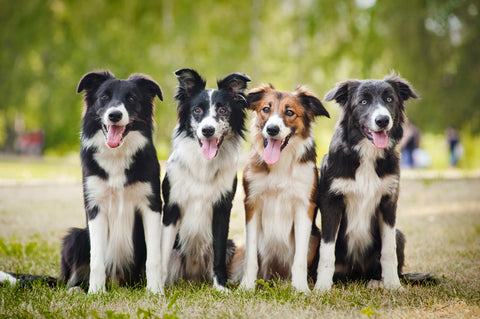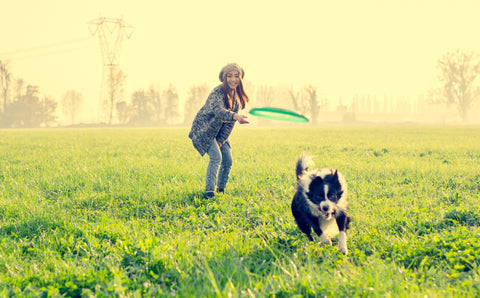
Is jumping bad for dogs?
Is jumping bad for dogs?
There are many opinions out there about dog joints and jumping. Is it harmless and healthy? Does it stress the joints? Can all breeds jump and play actively? It’s time to take a closer look.
The volume of information on how to help our dogs feel happy and healthy means that telling fact from fiction can be quite confusing. That’s where we come in! We’ve been speaking to the Lintbells veterinary advice team about dog joints and jumping to help you make the best choices for your four-legged friend.
How jumping affects your dog’s joints – the basics
The effect of jumping on your dog’s joints depends on circumstance and concerns what’s happening in your dog’s body as she or he jumps. Historically, dogs and their wild cousins, wolves, have needed to leap and jump to survive. For our domesticated dogs however, it’s a question of repetition, surfaces, load, strain, scale, and the effect of these details on the body.

It’s useful to consider the act of jumping from a dog’s perspective – understanding what’s happening physically helps us understand how and why different kinds of jumping affect our dog’s joints. We’ve asked the Lintbells veterinary team to give us the basics.
How does a dog jump up?
When your pooch prepares to take off, he or she shifts weight back into the large muscles of the back legs and onto the back-leg joints. The activated back end of propels your dog up and forward like a coiled spring being released.
This action requires a full range of motion in the back leg joints including the stifle and the hip and tarsal (hock), and of course, activation in all the supporting muscles. When they come to land, the front legs are mobilised, flexing and extending to brake and steady the dog.
Though these actions are perfectly natural, as you can imagine, it takes more out of your dog’s joints than walking or running around on flat ground. Vets refer to the additional stress on the body as ‘increased load’.
How does a dog jump down?
The act of jumping down takes less muscular work – it’s when your dog puts the brakes on that he or she might risk a twist or strain.
To get down off a couch or bed, your dog uses their body weight for downward momentum. Once they land, they’ll then ‘brake’ through the front section of their body. The front legs and shoulders suddenly take much more weight and strain than if walking or running on flat ground, especially if your pooch is carrying an extra pound or two. Again this is ‘increased load’ at work.
What about different surfaces?
This is a big factor. Jumping from hard to soft – or soft to slippery – adds another layer of complexity. Your dog must counter slippery surfaces such as linoleum with their own muscles, or may risk toppling over on impact. This can cause what’s called ‘eccentric contractions’, leading to twists, strains and sprains.
Imagine jumping from a high wall onto a soft mattress and trying to stay on your feet when you land – you get the picture. Clutter, slippery floors, and rugs can also cause problems. Twisting or straining on landing to avoid hazards will mean more work for the muscles and joints.
Is the dog’s breed and size a factor?
Of course. If your dog is a tiny toy, they may have to jump twice or three times their height to join you for a snuggle. Some breeds and mixes are more prone to accidents and/* incidents, and obesity plays a part too. Unfortunately, if your dog is carrying extra weight, their joints take the stress, which can make a risky action even more problematic.

Jumping and dog joints: fact or fiction?
We’ve presented the Lintbells veterinary team with some of the most common statements about jumping and dog joints and asked them to sort the facts from the fiction.
“Dogs shouldn’t go up and down stairs”
Not true. Most healthy adult dogs can manage carpeted stairs well. Stairs or steps do require greater range of motion in both the front and back leg joints when compared to walking on flat ground. However, the shift in the dog’s centre of gravity is counteracted by the lowered height the dog needs to negotiate. Stairs can be a challenge for the smallest breeds and dogs whose joints need extra care. Ramps, or being carried or supported with a sling is a good idea in these cases – talk to your vet for advice.
“Jumping in and out of the car is bad for my dog”
It depends - on your car and your dog! A high SUV, a slippery boot blanket and a small or older dog is a very different scenario to a low estate car with a rubber mat in the boot. The best solution is to use a portable pet ramp. If your dog gets used to ramps when they’re young and agile, life will be easier for both of you if jumping becomes a struggle as they age.
“Dogs shouldn't jump on and off couches”
True. Jumping on and off the couch isn’t great for dogs because of the combination of different surfaces. Going from hard to soft (and vice versa) increases the likelihood of twists and injuries, as does repeating a ‘high load’ activity over and over.
“Jumping on the bed won’t harm my dog”
Not true. Although, of course it depends on your bed, your bedroom and your dog. It’s safer to lift your dog up for a bedtime snuggle or use a ramp – or at least lift them back down from the bed, especially if your bed is high. Jumping on and off the bed is a ‘high-load activity, with a mix of hard and soft surfaces that causes a lot of strain in your dog’s musculature and joints.

“Puppies shouldn’t be allowed to jump on furniture”
True. Growing joints are particularly vulnerable – and the behaviour you allow in puppyhood sets the model for adult life. We’d recommend training your pup to ‘wait’ and lifting them onto furniture if you want them to come up for a cuddle. It’s a polite habit for when you visit friends and family, too!
“Dogs shouldn’t be allowed to bounce and play on beds and trampolines”
Unfortunately, this is true. Many dogs love the bouncy feel of the bed or couch and will sometimes even use it as a ‘springboard’ if they’re having zoomies. We all know a pooch who loves to play on a trampoline given half a chance. However, bouncing on an uneven surface or – worse – from soft and springy to hard ground can increase the chance of injury.

“Jumping sports like agility are bad for dogs”
Not true. Although jumping increases the load on the joint, if the surfaces and heights are within a safe range, your dog is healthy, and you don’t overdo it, jumping is relatively safe. There is a risk of injury when partaking in any sport, but if you’re careful and responsible, you can minimise the risk so they are outweighed by benefits like increased fitness and a better bond between you.
Have you had any trouble discerning fact from fiction when researching whether jumping is bad for your dog? Share your experiences in the comments below or join our pet-loving community over on the Lintbells Facebook Page.





